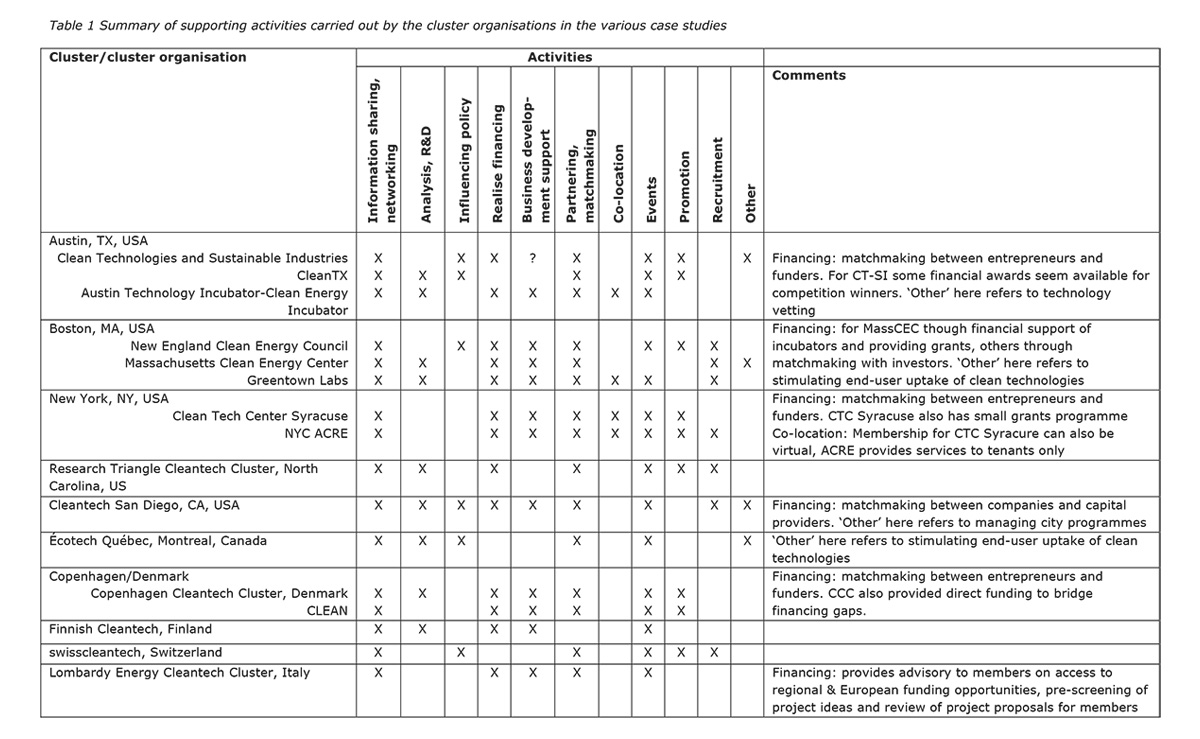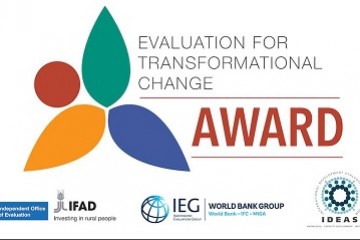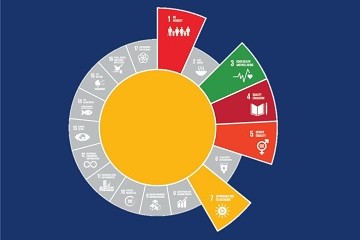Cleantech clusters a boost for local economies
Effect of clustering?
There is general consensus that clustering specific types of economic activity in one location provides economic benefits. In this context, a cluster is a geographical location where enough resources and competences reach a critical threshold, giving it a key position in a given economic branch of activity, and with a decisive sustainable competitive advantage over other locations. Clustering is thought to strengthen the competitive position by increasing the productivity of the companies in the cluster, by driving innovation in the field, and by stimulating the start-up of new businesses in the field. Cluster development has therefore become a focus for many government programs since the concept’s introduction in the 90ies.
In spite of this general consensus, there has so far been limited empirical evidence of the specific impacts of clustering on the local economy due to a lack of structural, long-term statistical data at the right granularity. This is especially the case for Cleantech clusters as these are generally relatively young, mostly starting in the last 5-10 years. Many Cleantech¹ clusters exist, and growth in recent years especially has been strong. Analytical publications, however, showed a peak around 2011-2012, with less structured analyses made public in recent years.
Given the increasing interest in clean technology and green growth around the world, there is a need for up-to-date insights into the real-life impact of Cleantech clustering to inform discussions between practitioners, policy makers and funders. As part of such a discussion, SQ Consult assessed the potential impact of Cleantech clustering on local or regional economies for Imperial College London, which aims to catalyse the formation of a Cleantech cluster in the greater London area.
Cleantech cluster cases
Given the challenges with using statistics as a source of information mentioned above, our assessment focused on the analysis of a number of Cleantech cluster case studies. On the basis of available literature as well as information of Cleantech cluster organisations such as the Global Cleantech Cluster Association, Cleantech.org and the European Cluster Collaboration Platform², a long-list of 25 Cleantech clusters was established. From this, 10 case studies were selected for detailed analysis, using criteria such as the comparability of the cluster to (and relevance for) the plans for the great London area in terms of the type of cluster and the cultural and policy environment, data availability on the impact of the cluster on the local economy and the maturity of the cluster, as well as the geographical distribution of case studies across different countries, to allow for a broader set of case study characteristics and experiences to feed into the lessons learned. As a result, the following 10 case studies were selected for further analysis:
- The Clean Technologies & Sustainable Industries cluster, in Austin, Texas, USA, including also the activities of CleanTX and the Austin Technology Incubator-Clean Energy Incubator;
- The New England (later Northeast) Clean Energy Council in Boston, Massachusetts, USA , including also the activities of the Massachusetts Clean Energy Center and Greentown Labs;
- The Clean Tech Center at the Syracuse Tech Garden in New York, USA, including also the activities of NYC ACRE and 5 other Cleantech incubators supported by the NY State Energy Research Development Authority;
- The Research Triangle Cleantech Cluster in North Carolina, USA;
- Cleantech San Diego, in California, USA.
- EcoTech Québec in Canada;
- The Copenhagen Cleantech Cluster in Denmark, including also the successor activities of CLEAN;
- Finnish Cleantech (Cluster) in Finland;
- Swisscleantech, based in Zurich, Switzerland;
- The Lombardy Energy Cluster in Italy, including also the successor/renamed activities of the Lombardy Energy Cleantech Cluster and the Lombardy Technological Cluster for Energy and the Environment.
The clusters and cluster organisations³ analysed show a great variety for many characteristics, including objectives, scope, target group and available resources. Table 1 provides an overview of the different type of activities each of the organisations provides to its target group. The organisations range from rather high-level organisations focusing on information sharing, networking and influencing public views and policies (e.g. CleanTX, swisscleantech, Ecotec Quebec, Research Triangle Cleantech Cluster) to very concrete activities such as providing space, access to piloting facilities and/or providing one-on-one support in developing business plans and achieving funding for a limited number of start-ups (e.g. Greentown Labs, NYC ACRE). A number of organisations also cover (most of) the range of activities, such as the Austin Technology/Clean Energy Incubator, Cleantech San Diego and the Copenhagen Cleantech Cluster.
Of course, the scope and type of services provided also relates to the available resources, which in turn depends on the business model used by the cluster organization. This ranges from rental fees (including support services, e.g. NYC ACRE) to paid memberships (e.g. Lombardy Energy Cleantech Cluster, Clean Technologies & Sustainable Industries in Austin, TX) to public and/or private funding obtained by the organization (e.g. Finnish Cleantech Cluster, Copenhagen Cleantech Cluster). For public funding, this closely links to the policy environment, e.g. the availability of dedicated funding programmes or banks, and/or the use of revenues from emission trading schemes or a surcharge on electricity users in New York State and Massachusetts to fund the supporting activities of NYSERDA and MassCEC (which can in turn support individual cluster organisations and incubators).
Table 1 Summary of supporting activities carried out by the cluster organisations in the various case studies (click to open in PDF)
Cleantech cluster impacts
Data availability on the impacts of specific cluster organisations is generally limited, anecdotal and usually only provided by the organization itself, while for the broader cluster/region better data is available, more often provided by independent analysis and covering more years. And while care must be taken in comparing trends across sources and clusters, focusing on comparing growth rates rather than absolute figures provides a reasonably robust basis for analysis.
Where data on the impact of the Cleantech sector on economic growth rates is available, the estimated positive impact is substantial, usually increasing growth rates with a factor 2-4 compared to other sectors or the economy as a whole. Other positive economic impacts for which data were available include:
- The impact on employment growth rates is similar, showing faster growth for the Cleantech sector with a factor 1.5 to 4 compared to other sectors or the economy as a whole.
- Cleantech jobs on average correspond to higher than average education levels and wages.
- Specifically for the US, export intensity of ‘clean economy’ jobs (in terms of the value of export per job) was 2x as high as that of the overall US economy.

Here it must be noted that no information was available on the direct impact of the cluster organization and its activities on economic growth rates. So the observed impact can be attributed to the presence of Cleantech activities, though not necessarily to the clustering activities or the cluster organization. In terms of the direct impacts of individual cluster initiatives of course vary strongly with the scope, type of activities, available resources and starting date:
- Direct jobs generated range from the hundreds (NYC ACRE, Greentown Labs) to the thousands (NECEC, Copenhagen Cleantech Cluster).
- Number of companies supported range from 20 (NYC ACRE) to over a thousand (NECEC⁴, Ecotech Québec and Finnish Cleantech Cluster).
- Funding raised for/by supported entrepreneurs range from zero (i.e. no activity to support this) through $32 million for NYC ACRE (in 4 years) to $1.2 billion for NECEC (in 11 years).
Policy models
The case studies suggest different development trajectories and drivers across clusters, even within one country, as shown below for some of the US case studies:
- The government of New York State made a conscious decision to implement a broad, top-down approach using public funding to establish Cleantech incubators in each region of the state after New York City’s Investment Fund highlighted the risk of the state losing out on the benefits of the Cleantech development (as it did with the information technology and biotechnology industries). As a result, the state made a strong effort to connect its under-utilised manufacturing and entrepreneurial base with the City’s financial sector and its green policy framework (focused thus far on users of Cleantech, not innovators) to develop a leadership in the Cleantech sector to benefit the local economy.
- In Massachusetts, developments started with a cluster organization, the New England Clean Energy Council initiated by the clean energy industry in 2006, which over time expanded to the broader North Eastern Clean Energy Council and covering multiple states. The state economic development agency (Massachusetts Clean Energy Center, MassCEC), dedicated to accelerating the growth of the clean energy sector across the Commonwealth of Massachusetts to spur job creation, deliver state-wide environmental benefits and to secure long-term economic growth was established in 2008. The private Greentown Labs incubator started in 2011, running (amongst others) also some publicly funded support programmes. Here, originally initiated by industry stakeholders, public and private activities may have iteratively catalysed each other, leading to an exponential development.
- In Texas, on the other hand, development of the Cleantech sector seems to be largely driven by the Cleantech/clean energy industry and selected research organisations, such as the University of Texas at Austin. In spite of a lack of an ambitious clean energy & climate policy or specific Cleantech support at the state level, a strong Cleantech cluster has developed in the Austin metropolitan region, with among the highest growth rates across US states and metropolitan regions.
While not valid across all cases, in general it seems that European initiatives tend to be more top-down, driven by public funding, while the American initiatives lean more heavily towards entrepreneurial drivers, which is in line with general cultural differences between the regions.
Lessons learned
Our analysis suggests that the presence of a Cleantech cluster is likely to have a significant positive impact on the local economy, with both economic growth rates and jobs growth increasing with up to a factor 2-3 compared to other sectors or the economy as a whole. It is also likely to lead to higher educated, higher paid jobs in the region, increase entrepreneurial activities and spur innovation. The largest direct impact of cluster organisations or initiatives on economic growth and employment can be expected when its support activities include helping its target audience achieve financing to bridge the gap between innovation and commercialization, i.e. bringing products and services to market. This can include direct financing or making activities finance-ready (support for developing sound business models and business plans) and connecting start-ups with financiers.
Different routes are possible for the start and evolution of Cleantech clusters, varying from organic, bottom-up development by Cleantech stakeholders and entrepreneurs, top-down, government driven programmes or a combined, iterative process in which private and public initiatives enhance each other. And while cluster organisations or initiatives vary widely in type of activities, scope and the availability of resources, they can play an important role in the development of Cleantech clusters, either as initiators, catalysts or implementers of cluster-supporting activities.
A supportive policy environment can be important for the success and sustainability of Cleantech cluster development. Not only can such an environment directly lead to more financial resources and a broader scope of activities of the cluster organization, public funding could also help leverage private financing for the organization and increase its longer-term financial viability. It can also provide an important signal to stakeholders and financiers of a long-term commitment, as well as increase transparency of the organisation’s activities and impacts. In addition, it can help streamlining policy frameworks and connecting the Cleantech development to manufacturing and employment policies as well as those addressing the financial sector. And finally, public sector involvement can help replicate and scale up the Cleantech activities in other locations.
¹ Cleantech, or clean technology, here is used as an umbrella term encompassing the investment asset class, technology, and business sectors which include clean energy, environmental, and sustainable or green, products and services, In line with the definition as provided by Cleantech.org.
² http://www.globalcleantech.org/, http://www.cleantech.org/, https://www.clustercollaboration.eu/cluster-network-sector/cleantech
³ We make a distinction between the ‘cluster organization’, carrying out concrete support activities for its target group, and the ‘cluster’, the regional grouping of cluster activities, which can be broader, and potentially also be served by multiple organisations.
⁴ Entrepreneurs coming to New York City to raise money and sell products, but creating the jobs and paying taxes elsewhere in the US.





